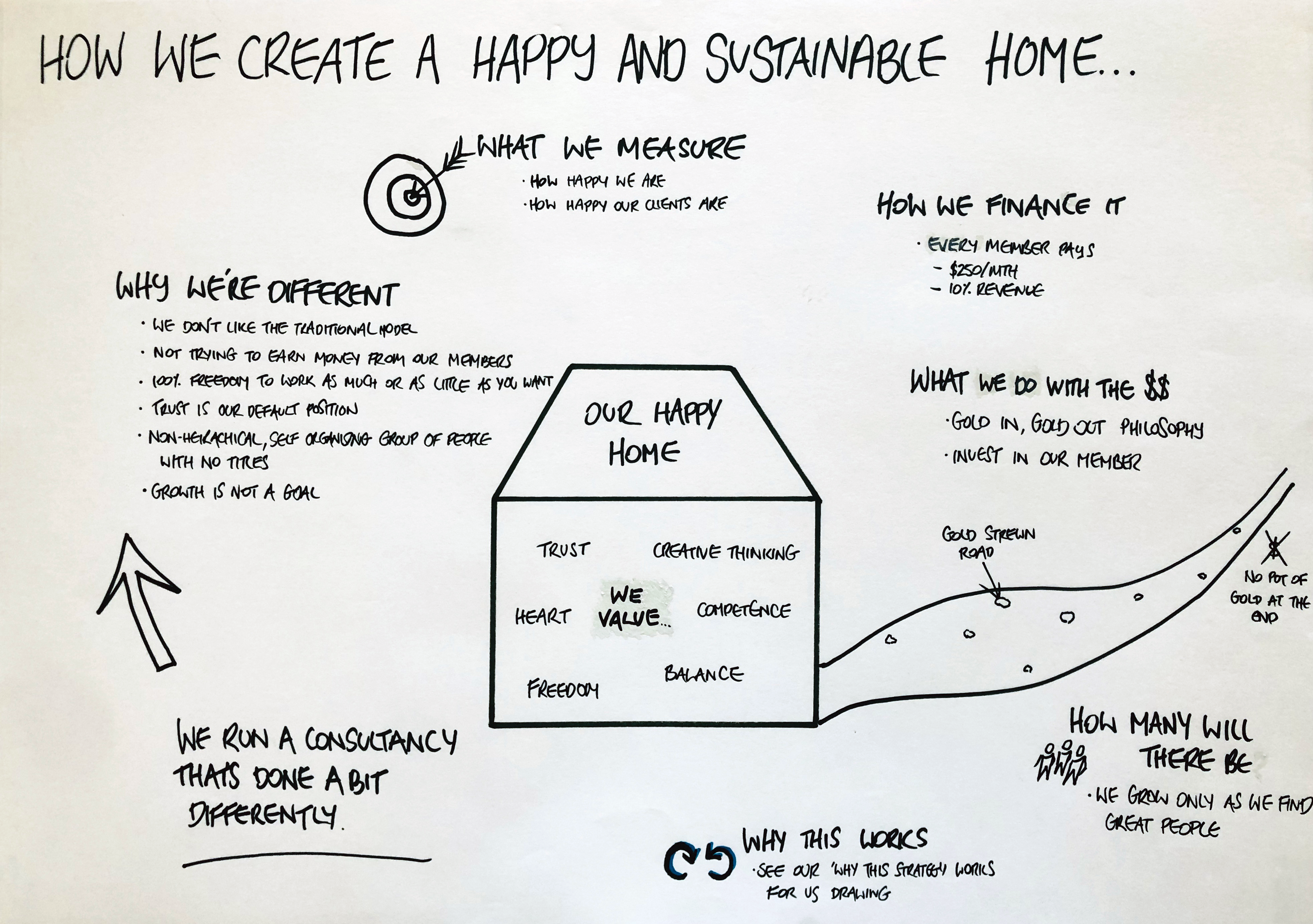How Organa works
Some may call this a strategy but for us, it’s about how we operate:

What do we measure?
We measure:
- How happy we are (see Happiness Index where we measure happiness qualitatively and quantitatively).
- How happy our clients are (actually, this point is partly aspirational, we currently measure our clients happiness qualitatively).
How do we finance the home?
To cover our costs, every Member contributes a fixed amount per month + % of the revenue they earn. The fixed contribution is $250/mth, and the variable contribution is usually around 8-12%, currently 10%. These contributions are intended only to cover Organa’s costs, so we check and review this semi-regularly, based on how much money we have in our coffers. If we have less than our desired liquidity buffer then we raise the contributions, and vice versa. Interestingly, we have lowered but never yet raised contributions.
Why a fixed + variable contribution? All of our Members have fixed and variable costs. Same with Organa. With fixed + variable contributions, we get a nice balance that acknowledges fixed + variable costs on both sides. Members feel this is a balanced approach.
We also have a ceiling, to limit the total contributions a Member pays to Organa per year. Some Members earn a lot more than others and we don’t want them to leave just because Organa gets too expensive. The ceiling is usually around $20,000 per year and it’s currently $15,000.
See our Economic model for concrete examples.
What do we do with the money?
The guiding principles are:
- Gold in, Gold out - you don’t need to put in serious cash to join Organa, and there’s nothing to cash out when you leave.
- No gold on the table - we actively try not to build financial value in the company.
- No pot of gold at that end - there’s no financial incentive to sell the company.
- A gold-strewn road - you keep most of what you earn, as you earn it.
- Continual improvement - where we can, and if the buffer builds up, we spend it on group activities; learning, coming together, fun.
Why don’t we try to build financial value? If Organa has a big pile of money, that creates a financial incentive to own or control the company, and increases the risk of conflict as the “value” of the company goes up and down. If we keep the company lean, with only a small liquidity buffer, then we don’t need to argue about who owns what. This can feel like a whacky model to people, afterall aren’t businesses designed to grow, make money, build economic value? Sure if that floats your boat, but it doesn’t float ours. We are driven by motives other than money.
See Economic model and Ownership model for more detail on how money flows through the system.
How many do we want to be?
- We don’t have a growth target. Growth is not a goal in itself.
- We grow only when we find fabulous amazing people.
For more see Recruiting.
How do we run the company?
- Lean & Agile - our approach is based on lean and agile principles and guidance from Reinventing Organisations.
- Meritocracy - we don’t have titles, managers, or reporting structures. There is no hierarchy, no CEO, no fulltime staff. Instead we are a meritocracy, which basically means your power to influence stuff is based on competence, interest and engagement. We have a few different ways we make decisions including Consent and Consensus (here’s how).
- Don’t ask for permission - if you want to start or change something, go ahead. The default answer to any request or idea is “Sure! If you believe in it and want to put time into it”. Very few mistakes are fatal or irreversible, so we encourage each other to just try things rather than seek permission.
- Simple models - we can come up with detailed rules and structures for any kind problem. But we try not to. We don’t want to overcomplicate things, and prefer to err on the side of simplicity. Better to have too few rules than too many, and better to follow high level guiding principles than low level detailed procedures.
For more info, see How we make decisions.
How do we differentiate?
How are we different from a typical consulting company?
- Organa doesn’t want to earn money from its Members.
- 100% freedom for all advisers (as long as they don’t “hurt the home”).
- Organa has no other goal than to provide a happy home.
How are we different from a typical network of independents?
- For the service Organa offers, we are then dedicated to Organa - that is, Members are encouraged to do all their work and invoicing through Organa. You can work outside of Organa as long as it doesn’t “hurt the home”.
- We commit to helping and supporting each other.
What does “hurt the home” mean?
Members can do work outside of Organa, as long as it’s not what Organa offers. Selling a product management course would be hurting the home, agile coaching would be hurting the home because these are services we offer. Working in a floristery because you happen to love flowers, wouldn’t hurt the home or serving as a Non Executive Director (NED) on Boards wouldn’t hurt the home because Organa doesn’t offer NED services.
Why does this strategy work?
See our separate topic: Why this model works.